Velda Newman interview: Colour, shape & texture
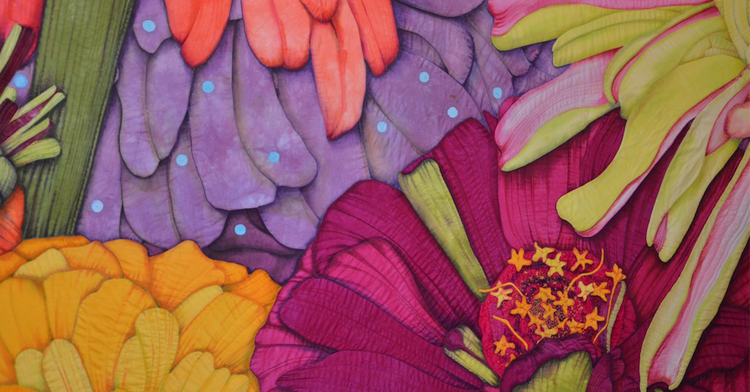
Velda Newman is a renowned quilt artist, writer and lecturer hailing from Northern California. She has become well-known for her exquisite craftsmanship in creating beautiful quilts, which are normally large scale and organic. As well as being exhibited internationally, Velda’s work has been showcased in publications such as the Quilter’s Newsletter and Threads magazine.
We first discovered Velda’s vibrant art when we were putting together our article about textile artists inspired by the natural world. The first thing that struck us about the work was the combination of colours, something that Velda discusses in detail in our interview with her.
Combining two mediums
TextileArtist.org: What was your route to becoming a quilt artist?
Velda Newman: From childhood, I have always been interested in art and stitching. I didn’t realize until much later that I could combine the two mediums. While in college, I took classes on basic design principles, composition, sketching and color theory which at the time, I thought would be used only in conjunction with paintings. Lucky for me, all of these skills transferred over beautifully to fiber.
What is your chosen medium?
Large scale art quilts are my main focus. Large scale work is always challenging because it takes such a big commitment of
time. Most of all, you need persistence, dedication, and a vision, plus a large space to work!
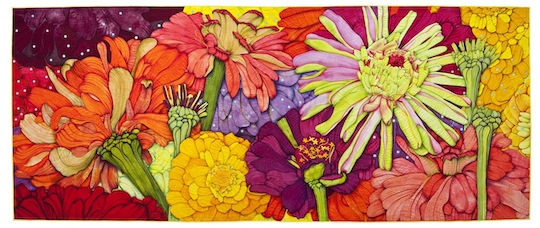
Velda Newman – Zinnia Quilt
Scale, perspective, balance, and colour
Can you explain the technique you use to make your quilts?
First, I’m looking for the subject of my next project. Most of the time, I choose something from nature. I want to be inspired by the possible colour choices, shapes and interesting texture which would go into the process of creating the piece.
As I start the design process, it almost always begins with colour. Few things elicit a more immediate or stirring response. Colour can sell a product, elevate a mood or evoke an emotion. It’s reassuring to know that with all its power, effective use of colour does not require a degree in colour theory. Great colour combinations are all around us, just look to nature for a teachable moment.
After colour, I focus on shape. Shapes are the building blocks of design. Each shape is broken down and simplified, and made into a “unit” which I can interpret into fabric. In my quilts, the challenge lies in giving a flat piece of material three dimensional characteristics, more like a painting. This is done by determining how the shapes relate to one another in scale, perspective, balance and colour. Through this process, you can achieve a winning composition.
Once the “cartoon” is drawn on graph paper to visualize the actual finished size of the piece, I use an overhead projector to scale up to a full size drawing. The result is what I call my master pattern. Using this as my guide, individual patterns are made.
Sometimes I make appliquéd quilts (shapes stitched to a background fabric), but more and more, I am making “collage” quilts, each shape is stitched to another shape, and there is no background fabric. This is the case for the ZINNIA quilt. Each flower is composed of many petals. Each petal is cut out of fabric, assembled into the flower shape and stitched together. All edges are basted to the back side. When all flower shapes are completed in this manner, they go on the wall, following the composition as drawn. These individual flowers are then stitched together to complete the top layer.

Velda Newman – Foxglove
The easy part
Working in textiles as a quilt artist, how do you deal with the colours you need?
That’s the easy, fun part. I hand dye all of my fabric. I usually dye a range of colours. For instance, if I am using greens I will dye 7 or 8 one yard pieces, ranging from pale chartreuse to forest green. Each colour in the project will be done is this manner, so I have lots of colour choices. I also use paint, ink, pencils, water based resist and colour remover. Anything to get the look that I’m after.
Do you use a sketch book?
When I decide on a subject for a piece, I usually sketch the layout for the composition, using graph paper. If working on what I call garden quilts, I take photos of the flowers from the time they start to bloom, to record details and to take close-ups.
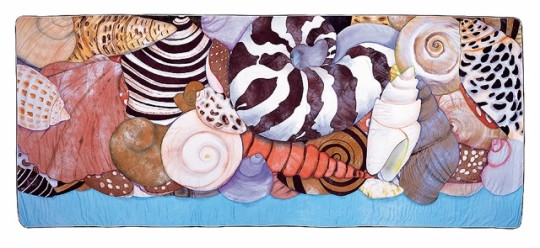
Velda Newman – Seashells
Going beyond realism
What currently inspires you and which other artists do you admire?
My focus has always been on nature, things that live and grow. Fall leaves, brilliant butterflies, sea shells and especially the intricate colours and forms of flowers. We all relate easily to natural subjects, whether portrayed in a painting, decorative arts or a quilt. I take artistic license with my designs, exaggerating color and scale for greater impact. I go beyond realism, to elaborate on nature, to capture the essence of a subject without attempting to replicate it. In the end, I just want to make something beautiful! My all time favorite artist is Kaffe Fassett. His love of color and design has inspired me for many years.
How do you decide where to exhibit?
The venue must have large, white walls! That’s the most critical objective to view my quilts to their best advantage. I have just had a solo exhibit at the Shelburne Museum in Vermont (USA). They had room for the large pieces without crowding. The exhibit opened in May and end in October 2013.
To find out more about Velda visit VeldaNewman.com.
If you’ve enjoyed our interview, why not share it on Facebook or Twitter by using the buttons below.

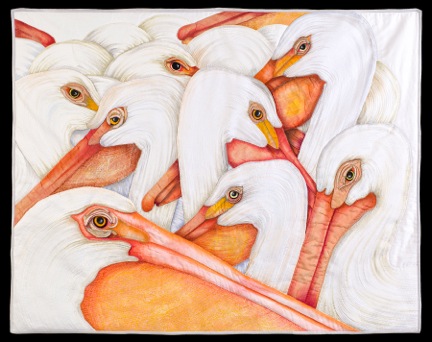
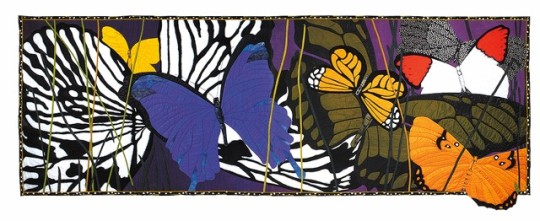















Wonderful art by Velda Newman !
Agreed!
Thank you for showcasing Velda Newman and her amazing quilts!!
You’re welcome. Velda is a very inspiring artist – thank you for being part of TextileArtist.org.
amazing